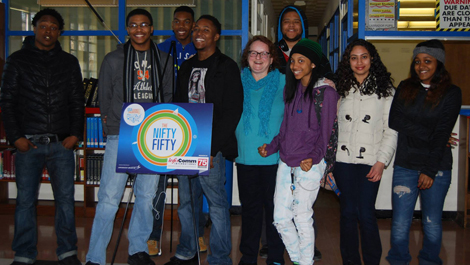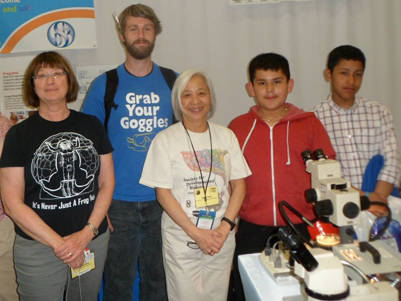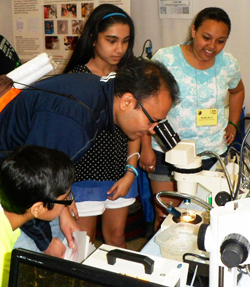2014 USA Science & Engineering
Festival Report
By Marsha E. Lucas
The Society for
Developmental Biology was an official partner of the
3rd USA Science & Engineering Festival held April
24-27, 2014 in Washington, DC. SDB has participated
in this biennial festival since 2010 and took a lead
this year in sponsoring several
developmental
biology-themed outreach activities.
The Society
nominated
Marnie Halpern (Carnegie Institution for
Science – Embryology) for the festival’s
Nifty Fifty
program in which scientists visit middle and high
schools to share with students their research and
promote careers in science, technology, engineering,
and mathematics (STEM). On March 13, Halpern visited
W.E.B. Dubois High School in Baltimore, Maryland
where she spoke to seniors about brain asymmetry in
zebrafish. Her lab studies developmental genes
essential for brain asymmetry and how left/right
differences influence fish behavior. Students
learned that behavioral laterality exists throughout
the animal kingdom including the direction a snake
spirals, handedness in humans, and which eye a fish
uses to check for predators versus look for food.
Her lab showed that fish with altered brain
laterality are more fearful and less adventurous.
|
 |
|
Marnie
Halpern (center) with students from
W.E.B. Dubois High School. |
On April 23, SDB
organized a
DC Metro STEM Event, Developmental
Biology, Birth Defects, and Diseases. This public
lecture, co-sponsored by the George Washington
University Office of the Vice President for
Research, was geared toward
middle and high school students and featured short
talks by several developmental biologists.
SDB President
Martin Chalfie (Columbia University) presented an overview
of developmental biology and the kinds of questions
developmental biologists ask.
Irene Zohn (Children’s
Research Institute, DC) introduced the neural tube
and how failure of the neural tube to close leads to
defects in the brain and spinal cord. She shared
about her research to find maternal dietary
supplements that can reduce the incidence of neural
tube defects.
Maximilian Muenke, a pediatrician at
the National Institutes of Health (Bethesda),
focused on a particular neural tube defect—holoprosencephaly.
Muenke had students in the audience identify
distinct physical features associated with this
birth defect and observe how the disease manifests
in mild to severely affected patients, particularly
within families.
Anthony LaMantia (George Washington
University, DC) showed how the similar organization
of genes between mouse and human chromosomes allowed
him to develop a mouse model for DiGeorge Syndrome—a
large deletion on human chromosome 22 that results
in developmental delay, learning disabilities, and
cleft palate to name a few. He can study the loss of
the same group of genes missing in the human
condition, in the mouse because their gene order is
evolutionarily conserved between the two species.
Finally,
Susan M. Smith (University of Wisconsin,
Madison) discussed how through a combination of The
Society for Developmental Biology was an official
partner of the 3rd USA Science & Engineering
Festival held April 24-27, 2014 in Washington, DC. SDB has participated in this biennial festival since
2010 and took a lead this year in sponsoring several
developmental biology-themed outreach activities.
|
 |
|
Matt Hobbs (2nd from left) brought
his students from Cesar Chavez Prep in
Washington, DC to the public lecture at
George Washington University and later
to the the Festival Expo. |
Students from Cesar
Chavez Prep--a public charter school in Washington,
DC—attended the event with their science teacher
Matt Hobbs. Their engagement with the speakers and
excellent questions made for a truly enjoyable
experience.
The 3rd USA Science
& Engineering Festival ended with the
Finale Expo
held April 25-27 at the Walter E. Washington
Convention Center. More than fifty volunteers
including high school students, scientists, K-12
teachers and friends helped out at the SDB exhibit
Developmental Changes Form All Creatures which
featured Xenopus, zebrafish and several plant
species.
|
 |
|
Visitors checking out Xenopus embryos |
Sally Moody of
George Washington University provided microscopes
along with Xenopus embryos and tadpoles. One
family was so intrigued by the frogs, they came back
the next day to examine the embryos after 24 more
hours of development.
BioEyes co-founder,
Steve
Farber of the Carnegie Institution for Science,
provided microscopes and zebrafish embryos, larvae,
and adults. Visitors were able to observe early
embryonic stages, see circulating blood and beating
hearts in older embryos, and distinguish between
male and female adult zebrafish.
Ben Feldman from
the Eunice Kennedy Shriver National Institute of
Child Health and Human Development at NIH
spearheaded an activity on gene expression in
zebrafish embryos. Using RNA in situ-labeled embryos
he highlighted how even at early stages of
development when the embryo is a ball of cells,
there are specific genes expressed in distinct
locations at distinct times.
|
 |
|
Visitors observe Arabidopsis seeds and
fern spores under the microscope with
Mother of Thousands in foreground. |
Zhongchi Liu of the
University of Maryland (College Park) provided a
microscope and plants for our exhibit on plant
reproductive strategies and the evolution of
flowering plants. This was the first year plant development was featured at SDB’s booth and it
proved to be a hit. Representative seedless vascular
plants, gymnosperms, and angiosperms were displayed
with their reproductive strategies highlighted.
People were able to observe under the microscope the
spores on the back of a fern leaf and the seeds
within the fruit of an Arabidopsis plant. The most
unique plant was the Mother of Thousands, an
angiosperm that reproduces by growing plantlets on
the outer edges of its leaves which eventually fall
off and become new plants.
This year, SDB also coordinated the
Evolution Thought Trail which brought together 12
scientific organizations with evolution themed
activities at the Expo. Festival goers who visited 3
booths along the trail won a prize. To see more
pictures from the festival expo
click here. SDB plans to participate in the festival when it
returns again in 2016.
|